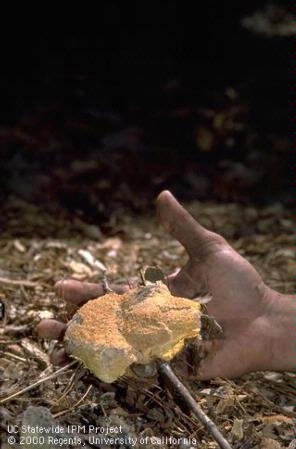The first email has come in. Every winter when it rains, we get calls about these weird gelatinous blobs in orchards and garden beds. They can look like vomit, be yellow, green, red, or blue colors and they can actually move. A rich forest floor or an avocado orchard with its thick mulch or a lemon orchard with piles of chipped prunings or a yard with mulched beds make for a great environment for slime molds to start moving with rainy weather, or when there has been significant irrigation.
Slime mold is an informal name given to several kinds of unrelated organisms that can live freely as single cells, but aggregate together to form multicellular reproductive structures. Slime molds were formerly classified as fungi but are no longer considered part of that kingdom. Although not related to one another, they are still sometimes grouped for convenience within the kingdom of Protista.
More than 900 species of slime mold occur all over the world. Their common name refers to part of some of these organisms' life cycles where they can appear as gelatinous "slime". Most slime molds are smaller than a few centimeters, but some species may reach sizes of up to several square meters and masses of up to 30 grams.
Many slime molds, namely the "cellular" slime molds, actually do not spend most of their time in this state. As long as food is abundant, these slime molds exist as single-celled organisms. When food is in short supply, many of these single-celled organisms will congregate and start moving as a single body. In this state they are sensitive to airborne chemicals and can detect food sources. They can readily change the shape and function of parts and may form stalks that produce fruiting bodies, releasing countless spores, light enough to be carried on the wind or hitch a ride on passing animals.
They feed on microorganisms that live in any type of dead plant material. They contribute to the decomposition of dead vegetation, and feed on bacteria, yeasts, and fungi. For this reason, slime molds are usually found in soil, lawns and on the forest floor, commonly on logs. However, in tropical areas they are also common on flowers, fruits and leaves. In urban areas, they are found on mulch or even in the leaf litter in gutters, and also grow in air conditioners, especially when the drain is blocked. One of the most commonly encountered slime molds is the wonderfully described yellow "Dog Vomit" slime mold Fulgio septica, found both in nature in forests, as well as mulched orchards.
Attached Images:
